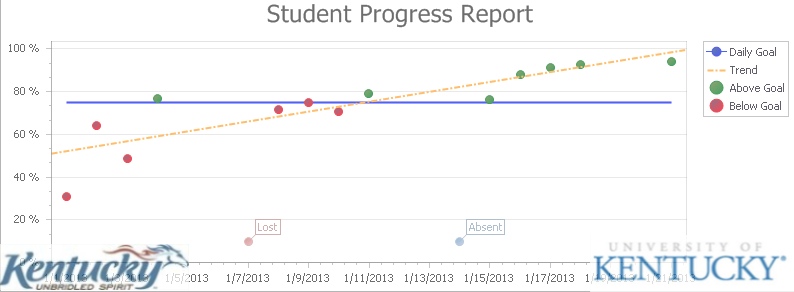Working to make a difference for children
who display challenging behavior
Kentucky Emotional-Behavioral
Disability:
Technical Assistance Manual: Behavioral Qualifiers
The EBD Task Force was established by the Kentucky Department
of Education in 1987 to guide Kentucky's educational systems change
efforts for students with or at risk of developing emotional and
behavioral disabilities. The multidisciplinary, multi-agency EBD
Task Force worked for five years to create a practical, objective
definition of the student population and procedural guidelines to
assist school districts in the screening and identification of students
for services under the EBD label.
Qualifier 1
Supportive Educational Assistance
Supportive educational assistance must be provided within the general program. Supportive educational assistance occurs when one student or a group of students is targeted for interventions dealing with an identified problem. The objective is to correct the problem in the current setting. Interventions are selected which have a high probability of being successful, given the nature of the problem in the current school environment. Further, the interventions are implemented for a sufficient period of time (e.g. at least 30 to 40 school days), and are evaluated to determine their effectiveness. This criterion emphasizes the school system's responsibility for using its resources to create a positive and appropriate learning environment for all students. Students who are a discipline problem or who create management problems in the classroom or school building are not necessarily disabled. Such students may need intervention or resources from general education or other community agencies to assist with this problem.
Extensive technology exists for creating curricular, instructional and behavior modifications for addressing the emotional-behavioral problems of the school population. Such modifications allow a wide range of students to function successfully within the parameters of the general program. An in-depth evaluation of the student's needs may be warranted if, following the implementation of a variety of appropriate classroom interventions, the student's behavior continues to interfere with the ability to profit from instruction.
Key Questions
In determining whether "supportive educational assistance" has been provided, the following questions should be addressed:
|
Qualifier 2
Across Settings
Determination of a student as EBD should rely on a number of different kinds and sources of information. Emphasis should be given to assessment of the student's problematic behavior within the total educational environment. The areas considered in evaluating across settings include such educational environments as classrooms, instructional groups, nonacademic and extracurricular groups, and community-based activities. The student's behavior in other settings (home, community) also should be considered if his or her educational performance is adversely affected.
Key Questions
In determining "across settings", the following questions should be addressed:
|
Qualifier 3
Marked Degree
In determining marked degree, attention is given to the frequency, duration, and intensity of specific problem behaviors.
Frequency-- refers to the number of times the behavior occurs over a given period of time.Duration-- refers to the average length of time the student engages in the behavior per occurrence.
Intensity-- refers to the relative force, loudness, or intrusiveness of the behavior.
Key Questions
In determining "marked degree" the following questions should be addressed:
|
Qualifier 4
Long Period of Time
Determination that a problem has occurred for a long period of time requires confirmation that the primary area of concern has been evident for a minimum of four months. This time frame is intended to distinguish between short-term problem situations and the need for special education services.
a) Short-term Situation(s): Situational crises may be expected in a variety of circumstances. A student may experience short-term conflict in situations such as death in the family, divorce/separation, new school, classroom reassignment, new teacher, physical illness, family financial crises, etc. No recent acute stress or isolated traumatic event such as these can adequately explain the problem behavior.
b) Single Incidents: The occurrence of single events (e.g., truancy, drug use, stealing, vandalism or running away from home) does not necessarily qualify a student as disabled or require a referral. The student's behaviors must coincide with the characteristics listed in the definition and must significantly impact on his or her academic or social development. Severe isolated incidents, such as behavior that is dangerous to the student or others, should lead to a variety of school interventions, one of which may be a referral and more immediate access to specialized services.
Key Questions
In determining "long period of time", the following questions should be addressed:
|
Documentation must be provided that all four qualifiers exist for either of the characteristics demonstrated in order to identify a student as EBD
